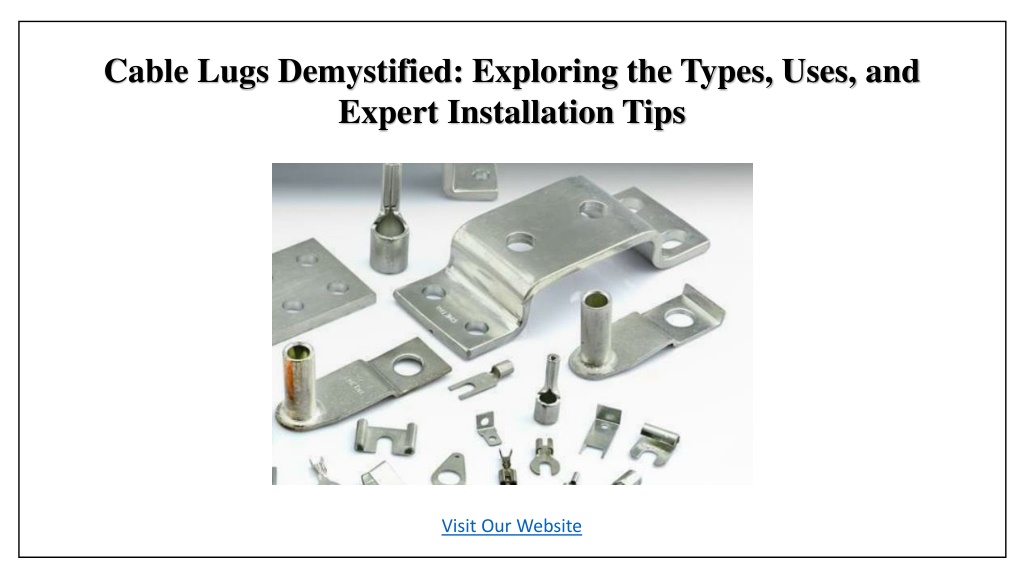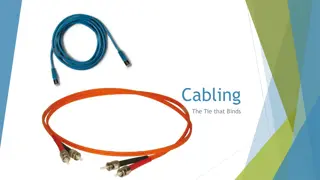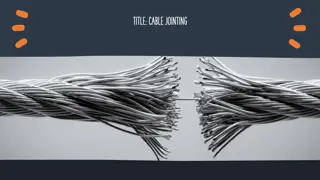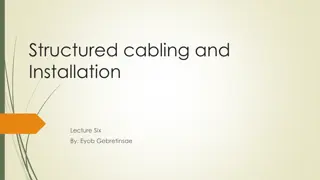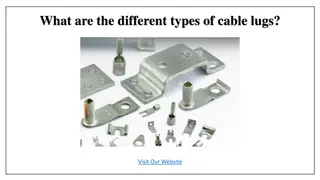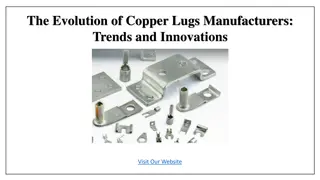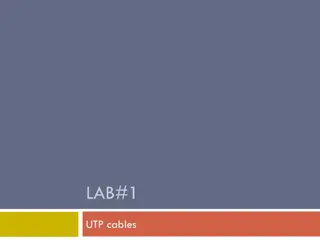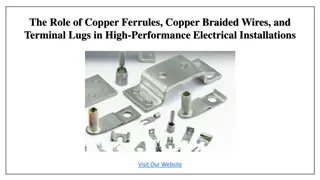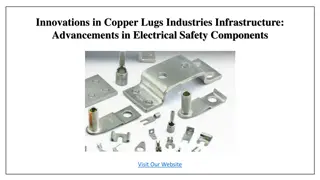Cable Lugs Demystified - Exploring the Types, Uses, and Expert Installation Tips
Unlock the essentials of cable lugs: types, uses, and expert tips for installation to ensure reliable connections and enhance electrical system performance.
Download Presentation

Please find below an Image/Link to download the presentation.
The content on the website is provided AS IS for your information and personal use only. It may not be sold, licensed, or shared on other websites without obtaining consent from the author. Download presentation by click this link. If you encounter any issues during the download, it is possible that the publisher has removed the file from their server.
E N D
Presentation Transcript
Cable Lugs Demystified: Exploring the Types, Uses, and Expert Installation Tips Visit Our Website
Introduction Cable lugs are critical components in electrical systems, providing a secure connection between cables and electrical devices. Choosing the right lug for your project ensures safety, performance, and longevity of your system. In this guide, we will explore the different types of lugs, their uses, and offer expert tips on installation to help you make the best choices. Visit Our Website
What are Cable Lugs? Cable lugs are connectors that help attach cables to various electrical equipment, ensuring a robust connection for current flow. They are typically made of materials such as copper or aluminum and are widely used in both industrial and residential electrical installations. From cable lug manufacturers in India to global suppliers, lugs are essential for delivering efficient electrical connections. Visit Our Website
Different Types of Cable Lugs & Their Usage Choosing the right cable lug depends on your specific electrical requirements. Let s dive into the most common types of lugs: Copper Lugs - Copper lugs are highly conductive, durable, and resistant to corrosion, making them a popular choice for heavy-duty applications. These lugs copper are ideal for high-voltage electrical installations, offering excellent performance in harsh environments. They are widely used in power distribution systems. Aluminium Lugs - Aluminium lugs are lightweight and cost-effective, suitable for medium to low-voltage applications. These lugs are frequently used in industries where weight is a consideration, like aerospace or transportation. Visit Our Website
Bimetallic Lugs - Bimetallic lugs are a combination of copper and aluminum, designed to eliminate issues caused by dissimilar metals connecting in electrical systems. These lugs are crucial when you need to connect aluminum cables to copper busbars, as they prevent galvanic corrosion and ensure conductivity. Copper Tubular Lugs - Copper tubular lugs are widely used in power transmission and distribution. Their tubular design allows for easy insertion of the cable, making them ideal for crimping and soldering. These lugs are commonly found in switchgear, transformers, and control panels. Terminal Lugs - Terminal lugs provide secure termination for electrical cables and are often used in control and automation systems. They offer reliable connections for small- to medium-sized conductors, and their compact design is suitable for confined spaces. Fork Type Lugs - Fork type lugs feature a fork-shaped design, making them easy to install and remove without entirely unscrewing the terminal. They are perfect for quick connections in low-current applications like automotive and household wiring. Visit Our Website
Bimetal Cable Lugs - Bimetal cable lugs are specifically designed for connecting aluminum conductors to copper busbars. They have a copper barrel and an aluminum palm, preventing electrochemical reactions that could degrade the connection over time. Insulated Cable Lugs - For enhanced safety, insulated cable lugs come with a protective cover to reduce the risk of electrical shock. These are commonly used in residential wiring and commercial applications where safety is paramount. Ring Type Lugs - Ring type lugs are designed for secure screw connections, with a ring shape that ensures the cable remains attached even when the screw is loosened. These are ideal for use in control panels and machinery where vibrations might occur. Copper Ferrules - Copper ferrules are used to terminate stranded wires, offering a smooth finish to the cable. They improve electrical connections and are mainly used in motor control systems and power distribution. Visit Our Website
Uses of Cable Lugs in Electrical Installations Cable lugs have a broad range of uses, including: Power Distribution: High-current applications, such as connecting power transformers or generators, often rely on copper lugs or bimetallic lugs for efficient power transmission. Grounding Systems: Proper grounding is essential for electrical safety, and copper bonded earth rods paired with copper tubular lugs are often used to ensure a reliable ground connection. Industrial Equipment: Heavy machinery and industrial equipment frequently require robust connections using ring type lugs and fork type lugs for control panels and automation systems. Residential Wiring: In homes, insulated cable lugs and terminal lugs are commonly used to ensure safe electrical wiring for appliances and lighting systems. Visit Our Website
Expert Tips for Installing Cable Lugs To ensure your cable lugs perform at their best, follow these expert tips: Select the Right Lug for the Application - Always choose lugs based on the current load, type of conductor, and environmental conditions. For instance, use bimetallic lugs for connecting aluminum conductors to copper components to prevent corrosion. Ensure Proper Crimping - Correct crimping is crucial for a strong connection. Invest in a high-quality crimping tool that matches the lug type. Improper crimping can lead to loose connections and overheating. Use Appropriate Insulation - In environments prone to moisture or high temperatures, it s essential to use insulated cable lugs to protect the connection from external elements and enhance safety. Match the Lug to the Cable Size - Ensure the cable fits snugly into the lug barrel. Oversized or undersized cables can affect the performance and longevity of the connection.
Conclusion: Understanding the different types of lugs and their usage is essential for ensuring optimal electrical connections, whether you're working on a small residential project or a large industrial installation. By choosing the right lug whether it's a copper tubular lug, bimetal cable lug, or fork type lug you can achieve greater reliability and safety in your electrical systems. For high-quality options, explore the wide range offered by cable lug manufacturers in India. Proper installation practices, as outlined above, will further guarantee the longevity and efficiency of your electrical connections. Visit Our Website
Thank You Visit Our Website
